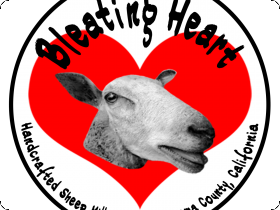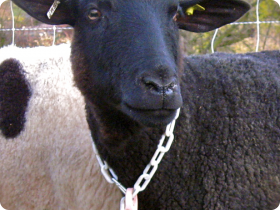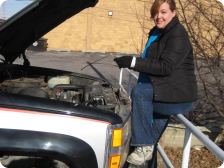Bleating Heart Cheese: An Interview with Seana Doughty
 Bleating Heart is one of the best sheep's milk cheeses on the market today, and cheesemaker Seana Doughty, who has the determination to drive from California to Wisconsin during winter to buy sheep, and the humor to name her wheels "Fat Bottom Girl," is a force to be reckoned with. After tasting her samples at Cowgirl Creamery and being blown away by the flavor produced by this first-time cheesemaker, I knew I wanted to interview her for "It's Not You, it's Brie." Because her story is so dynamic and fun, we're extending the interview to two posts- it's a long one, but her answers are fantastic. The interview was done via email, and my questions are in bold.
Bleating Heart is one of the best sheep's milk cheeses on the market today, and cheesemaker Seana Doughty, who has the determination to drive from California to Wisconsin during winter to buy sheep, and the humor to name her wheels "Fat Bottom Girl," is a force to be reckoned with. After tasting her samples at Cowgirl Creamery and being blown away by the flavor produced by this first-time cheesemaker, I knew I wanted to interview her for "It's Not You, it's Brie." Because her story is so dynamic and fun, we're extending the interview to two posts- it's a long one, but her answers are fantastic. The interview was done via email, and my questions are in bold.
California is cow land. Until 2009, there were only four licensed sheep's milk dairies in the state and their milk was harder to come by than a pizza without sundried tomatoes in the nighties. Now with ten East Friesian and Lacaune cross-breed sheep housed in a carport in her backyard, Seana Doughty has started the fifth certified sheep dairy in the state, and makes cheese that sells out within months. This is Seana of Bleating Heart Cheese. She makes Sonoma Toma and Fat Bottomed Girl.
It was very difficult for you to, first, find sheep's milk to make your cheese, than, second to find the animals you would call your own. Would you speak a little about those hardships?
When I first decided that I was going to make cheese, I had also decided that I would make sheep milk cheese – it’s my favorite, so that’s what I would make. Right. The harsh reality set in that getting sheep milk was more difficult than acquiring illegal drugs or guns! Not that I was seeking those things, but I would bet I could have bought those more readily than sheep milk.
There was absolutely NO sheep milk to be found anywhere. At that time (late 2008-early 2009), there were only 2 licensed sheep dairies in CA, Bellwether Farms and Rinconada Dairy, and both of them were using every last drop of milk for their own cheese production. In spring 2009, two more CA sheep dairies got licensed: Garden Variety Cheese, and Barinaga Ranch.
It was Marcia Barinaga who I connected with and who gave me the opportunity to buy a little bit of her flock’s milk and use her creamery to make my first cheese, Fat Bottom Girl. By the end of the 2009 season, Marcia realized that she needed all of her milk for her own cheese and would not be able to sell anymore. I spent a couple of months thinking about what I was going to do, calling around and talking to various people who may be thinking about starting a sheep dairy (there are quite a few talkers, not many doers) and where I might be able to get milk, with no real leads. So I had a decision to make – stop making sheep cheese until someday when somebody decides to start a sheep dairy and will sell me some milk, OR - start my own sheep dairy.

So…. I called up Paul Haskins at Swedish Mission Farm in Wisconsin, who I had visited earlier in the year to tour his sheep dairy operation. I told him my milk dilemma and convinced him to sell me 10 mature ewes, and to breed them for me as well. I didn’t know exactly where they were going to live yet, but I had a few ideas, the main one being my backyard which happens to be an apple orchard.

In December 2009 I bought a truck on craigslist and drove to Wisconsin and back, a 4200 mile trip, to pick up my flock. They settled in quite nicely in the orchard behind my house where I erected a carport and some portable electric fence. By the time the girls (as I call my ewes) had their babies, I had partnered with Kerry & Rex Williams, who are sheep ranchers living 3 miles from my house in Sebastopol. We formed an LLC, Black Oaks Sheep Dairy, built a “starter parlor” in an old barn on their farm, and got licensed on June 18th this year.
We now have a total of 84 East Friesian/Lacaune ewes that we have begun breeding this month and plan to increase the flock each season until we are eventually milking 200-300 prolific ewes. I visit my sheep often and do milk them from time to time (Kerry is the regular milker) and I am very involved in the overall operations and planning of the dairy, although not as hands on with the day-to-day care & feeding as my partners. This allows me to focus more on the growth of Bleating Heart and scaling up cheese production, knowing that my sheep are in good hands.
Why there are so little sheep in California yet so many in Wisconsin?
The only place in North America that has any sort of sheep dairy industry where there are farms that produce sheep milk for the sole purpose of selling milk (as opposed to making cheese) is Wisconsin. There are a few outliers in other states, but you could count them on one hand. Wisconsin is really the epicenter of sheep dairying in North America.
This is mainly due to the establishment of the sheep dairy at the Spooner Agricultural Research Station, a facility run by the University of Wisconsin. Why they took this initiative in Wisconsin as opposed to California or anywhere else, I’m not sure. I sincerely hope that California will someday soon have its own thriving dairy sheep industry so that we can produce more sheep milk products here. I will certainly do whatever I can to help make that happen. I am not a believer of shipping frozen milk or frozen curd across state lines or form other countries. I understand why other companies do this, I just don’t agree with it for both environmental and ethical reasons. More effort should be put into building up the local infrastructure(s).
Where and how did you learn how to make cheese?
I took 2 of the short courses in cheesemaking offered at Cal Poly, had a class with Margaret Morris, and also did a 3-day cheesemaking class with Moshe Rosenberg of UC Davis. Before that, I began by reading and studying - I bought many books, including dairy science textbooks (the books for hobbyists were of little value to me). I read, took notes, and then read some more. I studied cheese recipes, over and over, asking myself why certain steps are taken, what would happen if I did this or that differently?
There is a difference between simply following a recipe, and understanding WHY the recipe is written the way it is, why certain cultures are used, why you cut the curd to a certain size, why a cheese is aged at a certain temp or certain length of time, etc. I still do this type of inquisitive studying all the time. Although my degree is in sociology, I began college as a pre-med student so I have taken chemistry and biology classes - that helped immensely! The learning curve is going to be steeper for anyone who doesn’t have a familiarity with basic scientific lingo and principles.
I also worked as a cheesemonger for 6 months, further developing my knowledge of the cheeses of the world. Each day in the cheese shop was a new opportunity to taste and learn about more cheeses and I made every second count when I was there. This was absolutely invaluable. I cannot emphasize enough how much this helped.
Anyone can take a class and learn how to make gouda, feta, cheddar, etc. but I feel that is only part of it. To really become a good cheesemaker and understand cheese, my opinion is that one should have a good familiarity of the cheeses of the world.
In spring of 2009 I also spent 2 weeks in France, buying and eating massive amounts of cheese, visiting cheesemakers, and just marveling at the types of local cheeses they have there which are never exported or shipped outside those towns or regions, particularly in the Pyrenees where they have lots of sheep cheese and mixed milk cheeses. I was so in love with the area around the town of Laruns and the local cheeses you can buy at the town’s open market from the multiple small-scale cheesemakers, that I almost did want to come home! That trip was highly inspirational and I came back to CA with a even greater drive to create my own cheeses.
Were there cheese styles after which you modeled your wheels?
My goal was to create “American Original” cheeses. I had absolutely no desire to copy what Europeans have perfected over many centuries and generations. I recall a conversation with a well-respected cheesemaker last year, where I was talking about what type of cheese I wanted to make with sheep milk, and he said to me very matter-of-factly “you should just make Manchego.” Um, no thanks. Why would I make Manchego? The Spanish are already doing a rather stellar job with that, I cannot improve on that, I don’t even want to try.
My mode of operation boils down to American innovation with European inspiration. I first have a concept in my head, and then I try to execute it. I have this thing/talent/skill where I can smell and taste something in my mind, and I use this with my cheesemaking. I basically make cheese that I want to eat, getting inspiration from various places, with a firm commitment to not copying others- I wont ever do knock-offs!
 To be continued...
To be continued...

